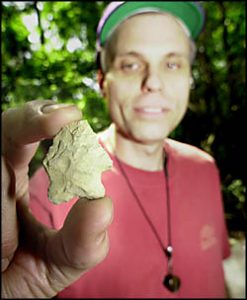Archaeologist searches for first North Carolinians
An archaeological site near Greenville and beside a little known tributary of the Tar River is producing a hot trail in an East Carolina University researcher’s hunt for the first North Carolinians.
The location, known as the Barber Creek Site, was discovered about 20 years ago, but has sat idle until late this spring when an the ECU Archaeology Summer Field School began excavations. Dr. Randolph Daniel Jr., an ECU assistant professor of anthropology, calls it a rare “stratified site,” perhaps the first one of its kind in the eastern part of the state, that has already produced evidence of human occupation dating back to 9,000 years ago. He said he knows of only two other stratified sites in the state — both in the piedmont area.

Daniel is directing the field school team of about a dozen graduate and undergraduate students. Over the past three weeks, the students have cleared the area and begun to dig square pits into the earth. Each shovel of dirt is carefully sifted for artifacts.
“What we’ve found indicates that there have been two major occupations here,” said Daniel.
They occurred in the early Woodland Period of 3,000 years ago and in the early Archaic Period of 9,000 years ago. Near the tops of the freshly dug pits there is about a foot of soil darkened by roots and decaying vegetation. At about 12-inches below the surface the students have recovered numerous pieces of pottery, animal bone and stone tools going back 3,000 years.
Digging deeper into the pits — two feet and more — and carefully sifting through yellow sand they have turned up stone tools that are much older. Daniel believes the projectile points and stone scrapers found at the deeper levels are thousands of years old. One spear point, recovered at the site, shows evidence of having been repeatedly sharpened and had possibly reached a stage where it had outlived its usefulness. The older stones were of a kind that occur naturally in the Piedmont region of the state rather than in eastern North Carolina.A scraper found in the pit may have come from as far away as Morrow Mountain near Albemarle in Stanley County.
“It indicates that there was movement of people during these periods,” said Daniel. He said the Barber Creek Site was an intensive operation or there were repeated visits by hunters and gatherers.
It is important and valuable today because it is an area that has never been plowed for agriculture or used for construction. The archaeological materials are embedded in layers of undisturbed earth that can be literally measured in time. Located east of Greenville on the Tar River’s south side, the property is owned by the Greenville Utilities Commission. The utilities department has been cooperative and supportive with the search project.
Daniel said additional research at the location might provide useful information for geologists trying to understand more about major weather occurrences and flooding. The heavy rains that followed Hurricane Floyd in 1999 flooded the entire property. At the site where the archaeology team is working, the water was as much as nine feet above the surface and well above the normal flood plain.
“If sand is indicative of floods, the site might tell geologists some things about flooding on the Tar River,” said Daniel. He said that the written records go back only about 100 years, but the layers of sand in the pits go back thousands of years. They might hold information that could determine whether last year’s flood could be called a “100-year flood,” a “500- year flood” or an even rarer occurrence. Over the next couple of week, Daniel and his team plan to sift through at least five additional pits for artifacts and clues about the early people.